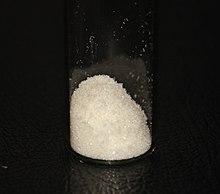1,10-Phenanthroline (phen) is a heterocyclic organic compound. It is a white solid that is soluble in organic solvents. The 1,10 refer to the location of the nitrogen atoms that replace CH's in the hydrocarbon called phenanthrene.

| |

| |
| Names | |
|---|---|
| Preferred IUPAC name
1,10-Phenanthroline[1] | |
| Identifiers | |
3D model (JSmol)
|
|
| 126461 | |
| ChEBI | |
| ChEMBL |
|
| ChemSpider | |
| DrugBank | |
| ECHA InfoCard | 100.000.572 |
| EC Number |
|
| 4040 | |
| KEGG | |
PubChem CID
|
|
| RTECS number |
|
| UNII |
|
| UN number | 2811 |
CompTox Dashboard (EPA)
|
|
| |
| |
| Properties | |
| C12H8N2 | |
| Molar mass | 180.21 g/mol |
| Appearance | colourless crystals |
| Density | 1.31 g/cm3 |
| Melting point | 118.56 °C (245.41 °F; 391.71 K)[2] |
| Boiling point | 409.2[2] |
| high[2] | |
| Solubility in other solvents | acetone, ethanol[2] |
| Acidity (pKa) | 4.84 (phenH+)[2] |
| Hazards | |
| Occupational safety and health (OHS/OSH): | |
Main hazards
|
mild neurotoxin, strong nephrotoxin, and powerful diuretic |
| GHS labelling: | |
 
| |
| Danger | |
| H301, H410 | |
| P264, P270, P273, P301+P310, P321, P330, P391, P405, P501 | |
| Related compounds | |
Related compounds
|
2,2'-bipyridine ferroin phenanthrene |
Except where otherwise noted, data are given for materials in their standard state (at 25 °C [77 °F], 100 kPa).
| |
Abbreviated "phen", it is used as a ligand in coordination chemistry, forming strong complexes with most metal ions.[3][4] It is often sold as the monohydrate.
Synthesis
editPhenanthroline may be prepared by two successive Skraup reactions of glycerol with o-phenylenediamine, catalyzed by sulfuric acid, and an oxidizing agent, traditionally aqueous arsenic acid or nitrobenzene.[5] Dehydration of glycerol gives acrolein which condenses with the amine followed by a cyclization.
Reactions
editOxidation of 1,10-phenanthroline with a mixture of nitric and sulfuric acids gives 1,10-phenanthroline-5,6-dione.[6]
1,10-Phenanthroline forms many coordination complexes. One example is the iron complex called ferroin.
Alkyllithium reagents form deeply colored derivatives with phenanthroline. The alkyllithium content of solutions can be determined by treatment of such reagents with small amounts of phenanthroline (ca. 1 mg) followed by titration with alcohols to a colourless endpoint.[7] Grignard reagents may be similarly titrated.[8]
References
edit- ^ Nomenclature of Organic Chemistry : IUPAC Recommendations and Preferred Names 2013 (Blue Book). Cambridge: The Royal Society of Chemistry. 2014. p. 211. doi:10.1039/9781849733069-FP001. ISBN 978-0-85404-182-4.
- ^ a b c d e Haynes, William M., ed. (2016). CRC Handbook of Chemistry and Physics (97th ed.). CRC Press. p. 3.444. ISBN 978-1-4987-5429-3.
- ^ Luman, C.R. and Castellano, F.N. (2003) "Phenanthroline Ligands" in Comprehensive Coordination Chemistry II. Elsevier. ISBN 978-0-08-043748-4.
- ^ Sammes, Peter G.; Yahioglu, Gokhan (1994). "1,10-Phenanthroline: A versatile ligand". Chemical Society Reviews. 23 (5): 327. doi:10.1039/cs9942300327.
- ^ Halcrow, Barbara E.; Kermack, William O. (1946). "43. Attempts to find new antimalarials. Part XXIV. Derivatives of o-phenanthroline (7 : 8 : 3′ : 2′-pyridoquinoline)". J. Chem. Soc.: 155–157. doi:10.1039/jr9460000155. PMID 20983293.
- ^ Dickeson, JE; Summers, LA (1970). "Derivatives of 1,10-Phenanthroline-5,6-quinone". Australian Journal of Chemistry. 23 (5): 1023. doi:10.1071/ch9701023.
- ^ Fagan, Paul J.; Nugent, William A. (1998). "1-Phenyl-2,3,4,5-Tetramethylphosphole". Organic Syntheses; Collected Volumes, vol. 9, p. 653.
- ^ Lin, Ho-Shen; Paquette, Leo A. (1994). "A Convenient Method for Determining the Concentration of Grignard Reagents". Synth. Commun. 24 (17): 2503–2506. doi:10.1080/00397919408010560.